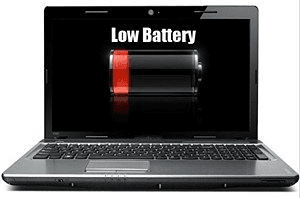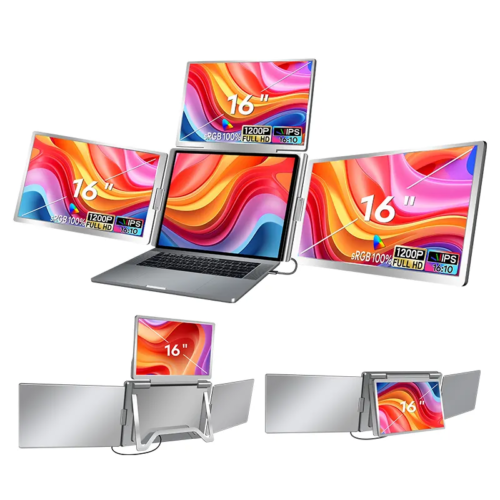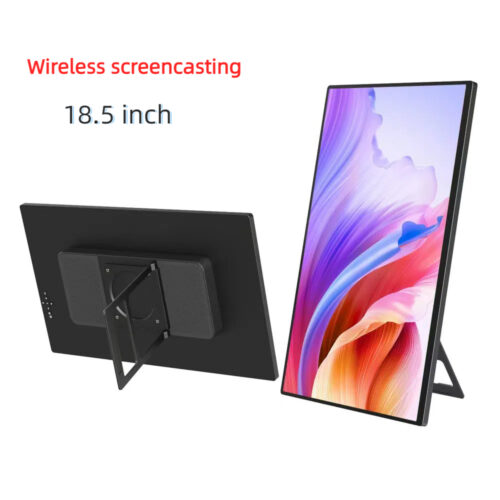Introduction:
Is Your Laptop Battery Draining Faster with a Screen Extender? Here’s What You Need to Know
As laptops have become indispensable for work, study, and entertainment, their portability and flexibility remain unmatched. However, in today’s multitasking world, one screen often feels limiting. Screen extenders—whether in the form of a second monitor, a portable monitor screen, or an extender monitor—offer a seamless way to expand your workspace.
But here comes the burning question: Can a laptop extender drain my battery?
If you’ve noticed your laptop’s battery depleting faster while using an extender, you’re not alone. This comprehensive guide dives into:
- How laptop extenders impact battery life.
- Key factors influencing energy consumption.
- Practical tips to optimize battery performance while using an monitor extender or portable monitor.
- Insights into the best tools and techniques for maintaining efficiency without sacrificing productivity.

1. The Relationship Between Laptop Extenders and Battery Consumption
1.1 Why Do Laptop Extenders Impact Battery Life?
Laptop extenders consume additional power due to:
- Increased Graphics Load: Extending your screen requires more GPU resources to render images on multiple displays.
- Power to the Extender: Many portable monitor or monitors extender draw power directly from the laptop via USB-C or HDMI connections.
- Bright Displays and Resolution: High-resolution displays with brighter settings naturally demand more energy.
1.2 Types of Extender Monitors and Their Battery Impact
Not all extenders affect your battery in the same way:
- Portable Monitor Screen: Compact and lightweight, these typically use USB-C connections, consuming moderate power.
- External HDMI Monitors: Monitors connected via HDMI often rely on an external power source, reducing the drain on your laptop’s battery.
- Three-Screen Extender Monitors: Multi-screen setups exert the most strain on GPU and battery resources.
2. Factors Influencing Battery Consumption
2.1 Extender Specifications and Design
- Power Efficiency: Monitors with low-power technology consume less energy.
- Resolution: 4K extender monitors demand significantly more power than 1080p screens.
- Refresh Rate: A higher refresh rate (e.g., 144Hz) accelerates battery drain compared to standard rates like 60Hz.
2.2 Laptop Battery Capacity and Age
- Older batteries tend to discharge more quickly, especially under heavy loads like multitasking with an extender monitor.
2.3 User Habits
- Using maximum brightness, keeping multiple applications open, and gaming on extended screens exacerbate power consumption.
3. How to Reduce Battery Consumption While Using a Laptop Extender
3.1 Adjust Display Settings
- Lower Brightness: Dim both your laptop and the portable screen to conserve energy.
- Reduce Resolution: Scale down the resolution of the extender monitor when high-quality visuals aren’t essential.
3.2 Optimize Connections
- Use External Power: Plug the extender laptop monitor into an external power source rather than relying on the laptop’s USB-C port.
- Choose Energy-Efficient Cables: USB-C cables optimized for power delivery ensure minimal energy waste.
3.3 Manage Tasks Effectively
- Avoid running high-GPU-demand applications like gaming or video editing while using an extender monitor.
- Close unnecessary applications or tabs in the background to reduce system load.
4. Practical Scenarios: Understanding Battery Drain in Real-World Use
4.1 Coding and Data Analysis
- vScenario: A data analyst uses a portable monitor to visualize complex datasets while coding on the laptop screen.
- Solution: Keep the extender monitor’s resolution at 1080p, and power it externally to optimize battery life.
4.2 Remote Work Setup
- Scenario: A digital marketer uses a three screen monitor setup for multitasking during client calls and report creation.
- Solution: Use screens with lower refresh rates for productivity tasks and ensure external power sources for all extender monitors.
4.3 Entertainment on the Go
- Scenario: Watching movies or gaming on a high-resolution extender monitor during travel.
- Solution: Reduce brightness and enable power-saving mode on both the laptop and the extender screen monitor.
5. Comparing Portable Monitors and Extender Monitors: What to Choose?
5.1 Portable Monitor Screen
- Advantages: Lightweight, compact, easy to set up.
- Drawbacks: Moderate battery drain when powered by the laptop.
5.2 Three-Screen Extender Monitors
- Advantages: Ideal for multitasking and maximizing productivity.
- Drawbacks: Requires significant GPU power and energy.
6. Maximizing Battery Life Without Sacrificing Productivity
6.1 Invest in Quality Extender Monitors
- Look for energy-efficient models with adjustable power modes.
- Use monitor extender with a power passthrough feature to offload battery strain.
6.2 Use External Batteries or Power Banks
- Power monitor extender with high-capacity power banks to extend usage time.
6.3 Update Software and Drivers
- Ensure your laptop’s operating system and GPU drivers are up to date for optimal power management.

7. Do Extender Monitors Drain Battery More Than Built-In Screens?
7.1 Built-In Screen vs. Portable Monitor Screen
- Portable monitor generally consume more power than laptops’ built-in displays due to additional GPU rendering requirements.
8. Key Takeaways and Practical Recommendations
8.1 Monitor Specifications Matter
When choosing an extender monitor, prioritize:
- Energy efficiency.
- Adjustable settings for brightness and resolution.
- Compatibility with external power sources.
8.2 Optimize Usage Habits
- Leverage software tools like power-saving modes and GPU optimization settings.
- Regularly monitor battery health and usage patterns.
Conclusion: Striking the Right Balance Between Portability and Performance
Using an extender monitor can indeed affect your laptop’s battery life, but the impact varies depending on factors like monitor type, power management, and user habits. By understanding how these devices influence energy consumption and employing practical solutions, you can enjoy the benefits of extended screen space without constantly searching for a power outlet.
Whether you’re working, studying, or gaming, technologies like the portable monitor ,extender laptop monitor, and other extender monitors can significantly enhance productivity and enjoyment—without compromising battery life if used wisely.
You may also like
-
 ONext 100% SRGB 16 Inch Quad Monitor 1 Cable for Trifold Laptop Monitors, Vibrant 3-Display for Windows & MacOS
ONext 100% SRGB 16 Inch Quad Monitor 1 Cable for Trifold Laptop Monitors, Vibrant 3-Display for Windows & MacOS -
 ONext 14″ Quad Monitor Laptop Screen Extender – FHD 1080P, 1 Cable for 3 Screens, Portable IPS for 13.6″-17.3″ Laptops (Win/Mac M1-M3)
ONext 14″ Quad Monitor Laptop Screen Extender – FHD 1080P, 1 Cable for 3 Screens, Portable IPS for 13.6″-17.3″ Laptops (Win/Mac M1-M3) -
 ONext 23.8″ FHD100Hz 100% sRGB Dual Screen Laptop Extra Monitor – 315° Adjustable for Work & Gaming
ONext 23.8″ FHD100Hz 100% sRGB Dual Screen Laptop Extra Monitor – 315° Adjustable for Work & Gaming -
 ONext 16″ Laptop Screen Extender Foldable Dual Stacked Portable Monitor with Built-in Hub, Magnetic Design, Single Cable for 1080P Triple Monitor Setup
ONext 16″ Laptop Screen Extender Foldable Dual Stacked Portable Monitor with Built-in Hub, Magnetic Design, Single Cable for 1080P Triple Monitor Setup -
 ONext 18.5″ Laptop Dual Screen Monitor 1080P 100Hz, Foldable Double Screen Laptop Display for Win/Mac
ONext 18.5″ Laptop Dual Screen Monitor 1080P 100Hz, Foldable Double Screen Laptop Display for Win/Mac -
 ONext 15.6″ Dual Screen 1080P FHD Stacked Folding Triple Monitor HDMI USB-C Portable Dual Monitor for Laptop Windows Mac (No Driver Needed)
ONext 15.6″ Dual Screen 1080P FHD Stacked Folding Triple Monitor HDMI USB-C Portable Dual Monitor for Laptop Windows Mac (No Driver Needed) -
 ONext 18.5 inch Portable Laptop Monitor ,Wireless screencasting Laptop Monitors with Kickstand
ONext 18.5 inch Portable Laptop Monitor ,Wireless screencasting Laptop Monitors with Kickstand -
 Portable Laptop Screen 16.1 inch Laptop Monitors Full HD, IPS, USB Type-C, Flicker Free, Blue Light Filter Silver With Foldable Stand
Portable Laptop Screen 16.1 inch Laptop Monitors Full HD, IPS, USB Type-C, Flicker Free, Blue Light Filter Silver With Foldable Stand -
 24 inch Stand By Me TV Movable Touch Television
24 inch Stand By Me TV Movable Touch Television